Reconstruction Method of 3D Turbulent Flames by Background-Oriented Schlieren Tomography and Analysis of Time Asynchrony
Abstract
:1. Introduction
2. Model
2.1. Tomography System Based on Background Schlieren Technology
2.1.1. Gladstone–Dale Relation
2.1.2. Ray Equation in Inhomogeneous Media
2.1.3. Measurement Model
2.2. Three-Dimensional Reconstruction
2.2.1. Ray Tracing Algorithm in 3D Flame Flow Field Based on kd Tree
2.2.2. Coordinate System Transformation
2.2.3. Algebraic Reconstruction Method Based on Radon Transform
2.2.4. Reconstruction of 3D Flame Field
2.3. Time Complexity of Ray Tracing
2.4. Uncertainty Evaluation of 3D Reconstruction
3. Turbulent Flame Dataset
4. Results and Discussion
4.1. Time Complexity of Ray Tracing in 3D Flame Field
4.2. 3D Reconstruction of Turbulent Flames Using the BOST System
4.3. Uncertainty of 3D Reconstruction with Time Asynchrony
5. Conclusions
- (1)
- The efficiency of ray tracing is accelerated by k-d trees in the 3D flame reconstruction process. The average number of nodes searched per ray is only 0.018% of the global number of nodes in a 3D flame system with 3.07 million grid nodes.
- (2)
- A double-cubic interpolation method for estimating the unknown orientation power spectral function in a polar coordinate system is proposed. The method’s applicability to 3D reconstruction performance is evaluated in terms of temperature and density fields, respectively, using the Sandia turbulent jet-diffusion flame as the study object. The results show that this method’s RMSE of the cross-section density for 3D reconstruction is below 0.1 kg/m3. In addition, the RMSE of the cross-section temperature is below 270 K.
- (3)
- Uncertainty analysis is performed by physical model-based flame reconstruction through k-d tree accelerated ray tracing. The relationship between the uncertainty of the 3D reconstructed temperature and density fields with the variance of the measurement is discussed for time asynchronous variance of 0.1 ms, 0.5 ms, and 1 ms, respectively. Overall, the uncertainties are positively correlated with the time asynchronous variance. For the time asynchronous variance of 1 ms, the density uncertainty of the 3D reconstruction is below 1.6 × 10−2 kg/m3, and the temperature uncertainty is below 70 K, which means that the time asynchronous effect must be considered in experimental measurements.
- (a)
- These preliminary results need to be further validated with more significant and more types of meshes. The current geometric model includes only standard flame CFD meshes. More orders of magnitude of grid parameters should be considered. Future work will address the accelerating effect of the k-d tree on the ray tracing process based on different orders of magnitude of nodes.
- (b)
- The flame model used in this paper is a standard Sandia turbulent jet diffusion flame. This is a common type of burner. Further discussion is needed to analyze the effects of time asynchrony for different types of combustors and at different Reynolds numbers. The analytical mechanism of these time asynchronies is a significant concern in the 3D reconstruction process. We will focus on the results of time asynchrony for different fuels, combustors, and Reynolds numbers.
Author Contributions
Funding
Institutional Review Board Statement
Informed Consent Statement
Data Availability Statement
Acknowledgments
Conflicts of Interest
References
- Liu, H.; Wang, Y.; Yu, T.; Liu, H.; Cai, W.; Weng, S. Effect of carbon dioxide content in biogas on turbulent combustion in the combustor of micro gas turbine. Renew. Energy 2020, 147, 1299–1311. [Google Scholar] [CrossRef]
- Grauer, S.J.; Unterberger, A.; Rittler, A.; Daun, K.J.; Kempf, A.M.; Mohri, K. Instantaneous 3D flame imaging by background-oriented Schlieren tomography. Combust. Flame 2018, 196, 284–299. [Google Scholar] [CrossRef]
- Wei, J.F.; Ye, M.; Zhang, S.L.; Qin, J.; Haidn, O.J. Modeling of a 7-elements GOX/GCH4 combustion chamber using RANS with Eddy-Dissipation Concept model. Aerosp. Sci. Technol. 2020, 99, 105762. [Google Scholar] [CrossRef]
- Wei, J.F.; Zhang, S.L.; Zuo, J.Y.; Qin, J.; Zhang, J.L.; Bao, W. Effects of combustion on the near-wall turbulence and performance for supersonic hydrogen film cooling using large eddy simulation. Phys. Fluids 2023, 35, 035112. [Google Scholar] [CrossRef]
- Liu, H.C.; Huang, J.Q.; Li, L.; Cai, W.W. Volumetric imaging of flame refractive index, density, and temperature using background-oriented Schlieren tomography. Sci. China Technol. Sci. 2021, 64, 98–110. [Google Scholar] [CrossRef]
- Jin, Y.; Zhang, W.; Song, Y.; Qu, X.; Li, Z.; Ji, Y.; He, A. Three-dimensional rapid flame chemiluminescence tomography via deep learning. Opt. Express 2019, 27, 27308–27334. [Google Scholar] [CrossRef] [PubMed]
- Nygren, J.; Hult, J.; Richter, M.; Alden, M.; Christensen, M.; Hultqvist, A.; Johansson, B. Three-dimensional laser induced fluorescence of fuel distributions in an HCCI engine. Proc. Combust. Inst. 2002, 29, 679–685. [Google Scholar] [CrossRef]
- Li, T.J.; Gao, P.; Zhang, C.X.; Yuan, Y.; Liu, D.; Shuai, Y.; Tan, H.P. Meshed axisymmetric flame simulation and temperature reconstruction using light field camera. Opt. Lasers Eng. 2022, 158. [Google Scholar] [CrossRef]
- Li, T.J.; Li, S.N.; Yuan, Y.; Wang, F.Q.; Tan, H.P. Light field imaging analysis of flame radiative properties based on Monte Carlo method. Int. J. Heat Mass Transf. 2018, 119, 303–311. [Google Scholar] [CrossRef]
- Li, T.J.; Yuan, Y.; Zhang, B.; Sun, J.; Xu, C.L.; Shuai, Y.; Tan, H.P. Experimental verification of three-dimensional temperature field reconstruction method based on Lucy-Richardson and nearest neighbor filtering joint deconvolution algorithm for flame light field imaging. Appl. Therm. Eng. 2019, 162, 114235. [Google Scholar] [CrossRef]
- Li, T.J.; Zhang, C.X.; Liu, D. Simultaneously retrieving of soot temperature and volume fraction in participating media and laminar diffusion flame using multi-spectral light field imaging. Int. J. Therm. Sci. 2023, 193, 108472. [Google Scholar] [CrossRef]
- Sanned, D.; Lindström, J.; Roth, A.; Aldén, M.; Richter, M. Arbitrary position 3D tomography for practical application in combustion diagnostics. Meas. Sci. Technol. 2022, 33, 125206. [Google Scholar] [CrossRef]
- Nicolas, F.; Todoroff, V.; Plyer, A.; Le Besnerais, G.; Donjat, D.; Micheli, F.; Champagnat, F.; Cornic, P.; Le Sant, Y. A direct approach for instantaneous 3D density field reconstruction from background-oriented Schlieren (BOS) measurements. Exp. Fluids 2015, 57, 13. [Google Scholar] [CrossRef]
- Liu, H.; Shui, C.; Cai, W. Time-resolved three-dimensional imaging of flame refractive index via endoscopic background-oriented Schlieren tomography using one single camera. Aerosp. Sci. Technol. 2020, 97, 105621. [Google Scholar] [CrossRef]
- Choudhury, S.P.; Joarder, R. High-speed photography and background oriented Schlieren techniques for characterizing tulip flame. Combust. Flame 2022, 245, 112304. [Google Scholar] [CrossRef]
- Cai, H.; Song, Y.; Ji, Y.; Li, Z.; He, A. Direct background-oriented Schlieren tomography using radial basis functions. Opt. Express 2022, 30, 19100–19120. [Google Scholar] [CrossRef]
- Grauer, S.J.; Mohri, K.; Yu, T.; Liu, H.; Cai, W. Volumetric emission tomography for combustion processes. Prog. Energy Combust. Sci. 2023, 94, 101024. [Google Scholar] [CrossRef]
- Yang, J.; Ma, Z.; Huang, L.; Li, X.; Jiang, H.; Yang, H.; Zhang, Y. Ignition measurement of non-premixed propane with varying co-flowing AIR through high-speed Schlieren stereoscopic colour imaging. Therm. Sci. Eng. Prog. 2022, 30, 101250. [Google Scholar] [CrossRef]
- Wang, Y.F.; Zhu, X.M.; Jia, J.W.; Zhang, Y.H.; Liu, C.G.; Ning, Z.X.; Yu, D.R. Development of a circumferential-scanning tomography system for the measurement of 3-D plume distribution of the spacecraft plasma thrusters. Measurement 2023, 216, 112966. [Google Scholar] [CrossRef]
- Gao, P.; Li, T.J.; Yuan, Y.; Dong, S.K. Numerical approaches and analysis of optical measurements of laser radar cross-sections affected by aero-optical transmission. Infrared Phys. Technol. 2022, 121, 104011. [Google Scholar] [CrossRef]
- Gao, P.; Tao, D.X.; Yuan, Y.; Dong, S.K. A low-time complexity semi-analytic Monte Carlo radiative transfer model: Application to optical characteristics of complex spatial targets. J. Comput. Sci. 2023, 68, 101983. [Google Scholar] [CrossRef]
- Zhang, J.Y.; Shaddix, C.R.; Schefer, R.W. Design of “model-friendly” turbulent non-premixed jet burners for C2+ hydrocarbon fuels. Rev. Sci. Instrum. 2011, 82, 074101. [Google Scholar] [CrossRef] [PubMed]
- Torres-Monclard, K.; Gicquel, O.; Vicquelin, R. A quasi-monte carlo method to compute scattering effects in radiative heat transfer: Application to a sooted jet flame. Int. J. Heat Mass Transf. 2021, 168, 120915. [Google Scholar] [CrossRef]
- Tian, L.; Lindstedt, R.P. On the impact of differential diffusion between soot and gas phase species in turbulent flames. Combust. Flame 2023, 251, 112684. [Google Scholar] [CrossRef]
- Rodrigues, P.; Franzelli, B.; Vicquelin, R.; Gicquel, O.; Darabiha, N. Coupling an LES approach and a soot sectional model for the study of sooting turbulent non-premixed flames. Combust. Flame 2018, 190, 477–499. [Google Scholar] [CrossRef]
- Colman, H.M.; Darabiha, N.; Veynante, D.; Fiorina, B. A turbulent combustion model for soot formation at the LES subgrid-scale using virtual chemistry approach. Combust. Flame 2023, 247, 112496. [Google Scholar] [CrossRef]
- Kearney, S.P.; Guildenbecher, D.R.; Winters, C.; Farias, P.A.; Grasser, T.W.; Hewson, J.C. Temperature, Oxygen, and Soot-Volume-Fraction Measurements in a Turbulent C2H4-Fueled Jet Flame; Sandia National Lab. (SNL-NM): Albuquerque, NM, USA, 2015. [Google Scholar]
- Gori, G.; Guardone, A. VirtuaSchlieren: A hybrid GPU/CPU-based Schlieren simulator for ideal and non-ideal compressible-fluid flows. Appl. Math. Comput. 2018, 319, 647–661. [Google Scholar] [CrossRef]
- Amjad, S.; Karami, S.; Soria, J.; Atkinson, C. Assessment of three-dimensional density measurements from tomographic background-oriented Schlieren (BOS). Meas. Sci. Technol. 2020, 31, 114002. [Google Scholar] [CrossRef]

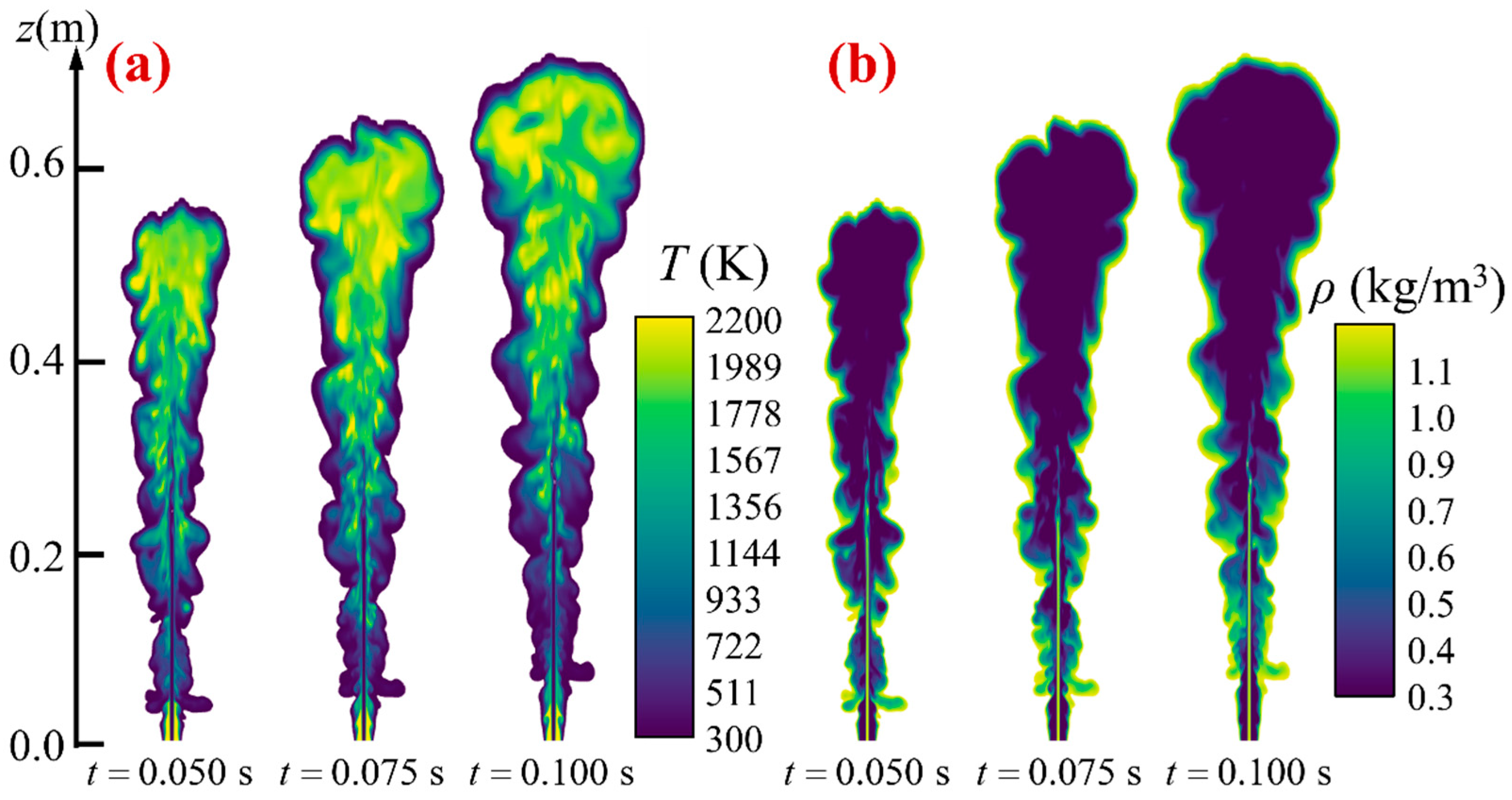
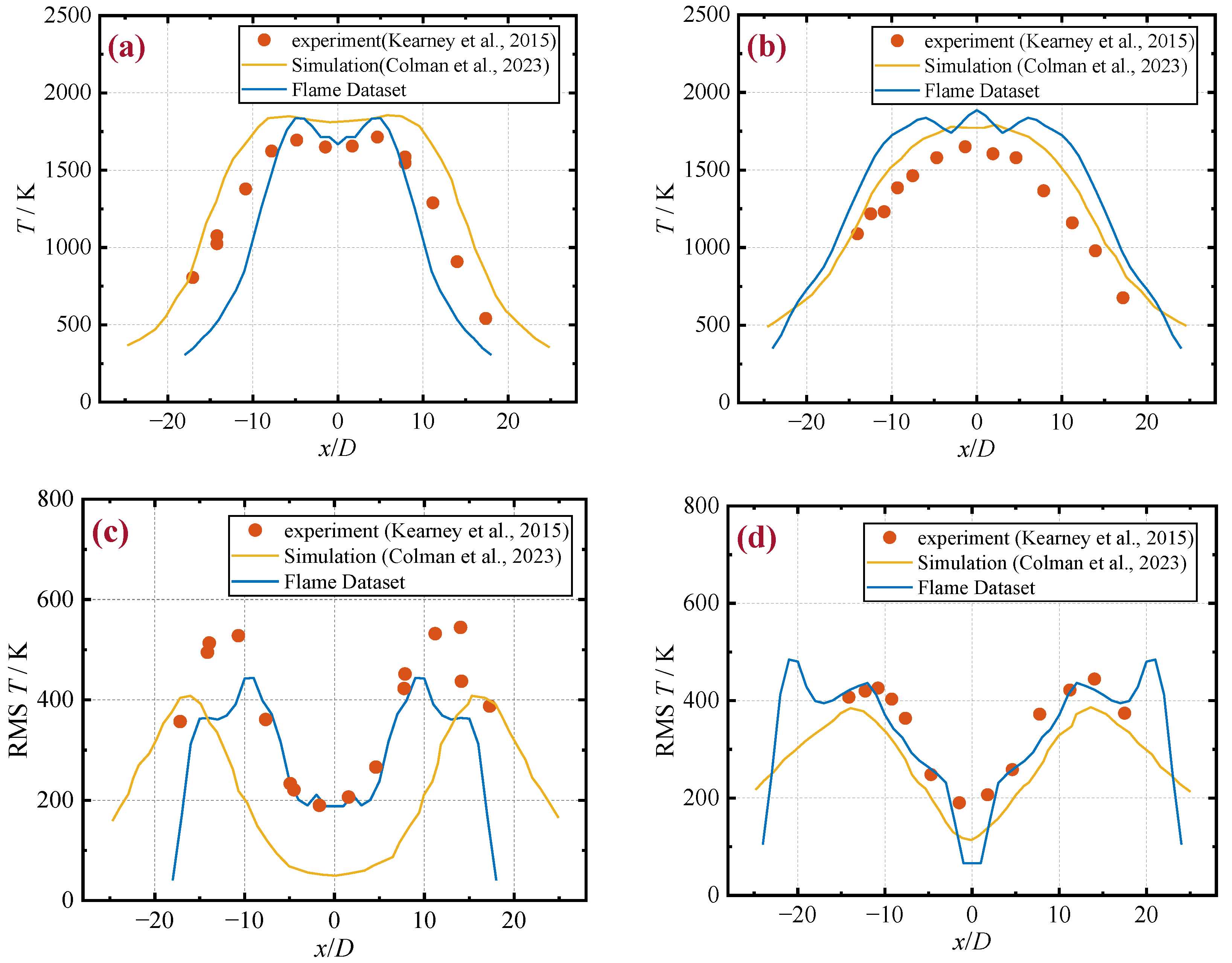

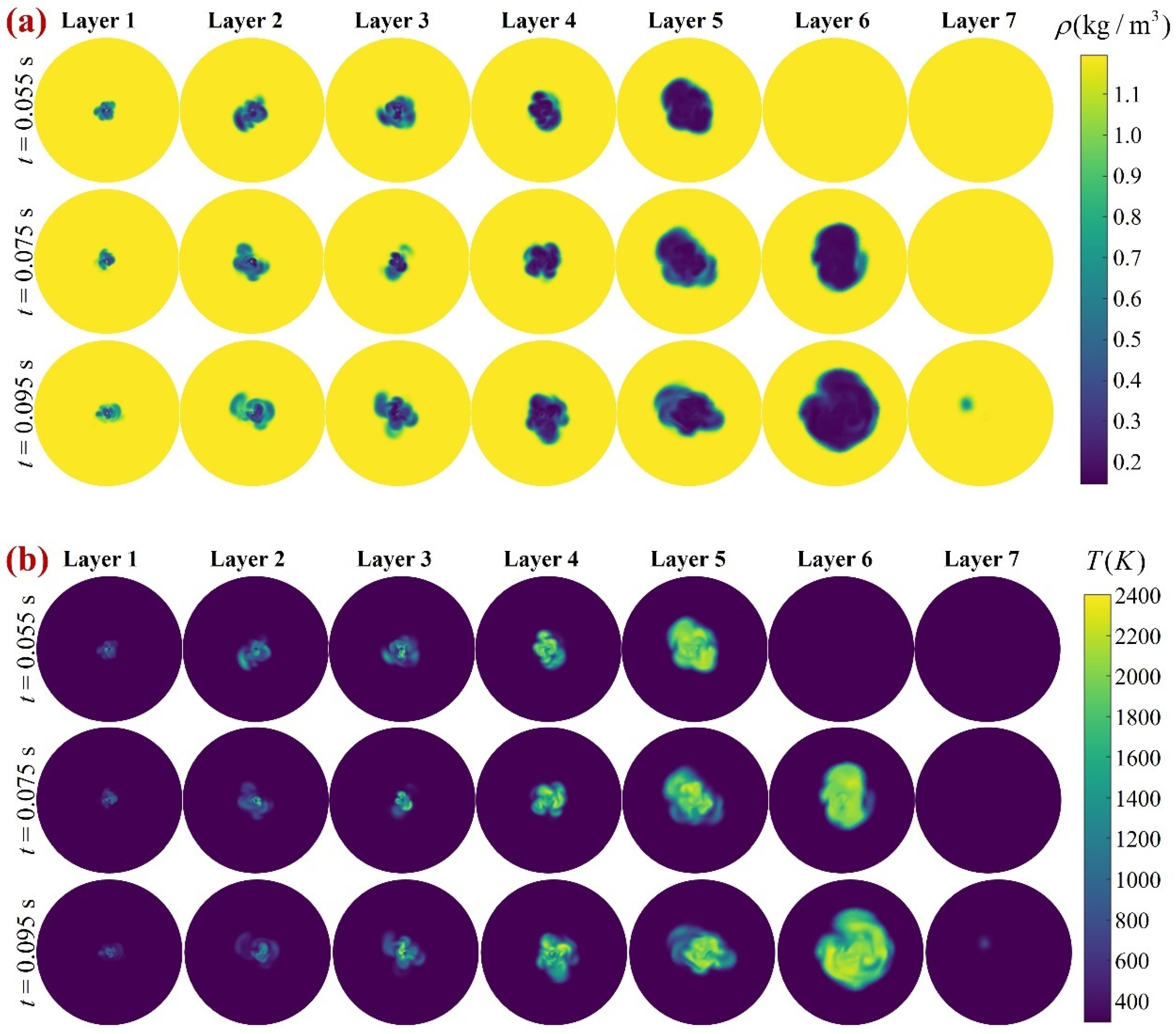
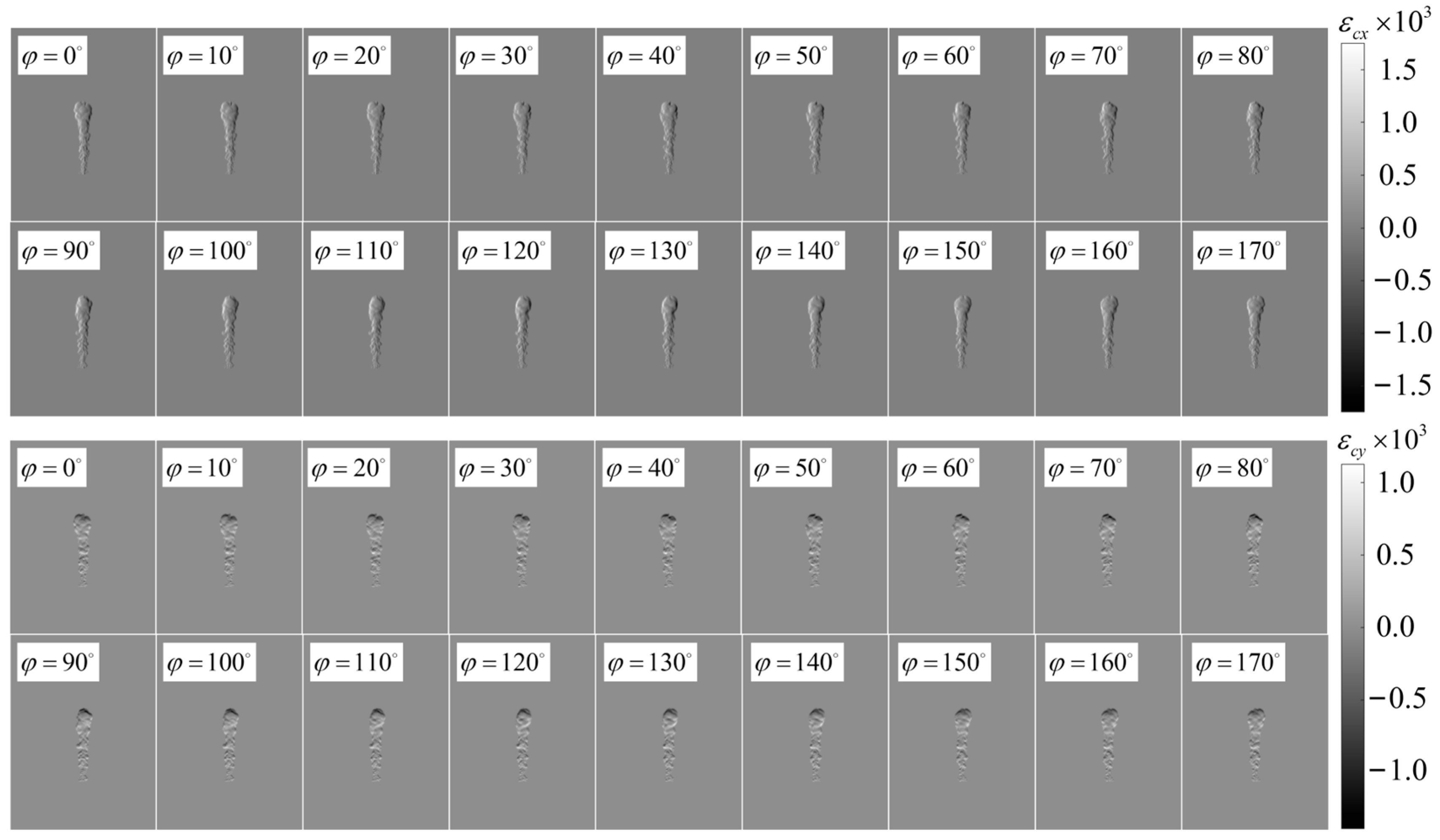
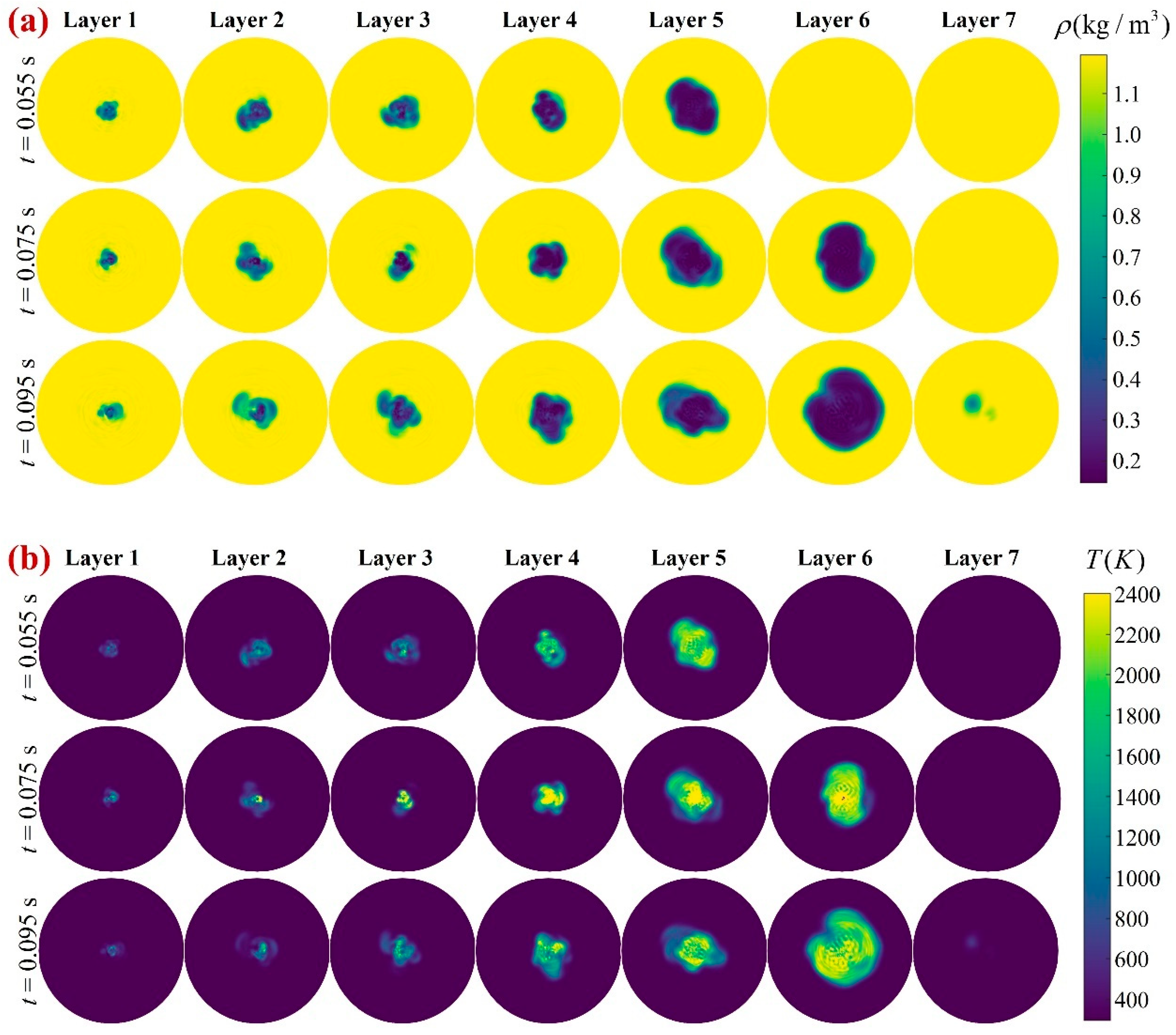
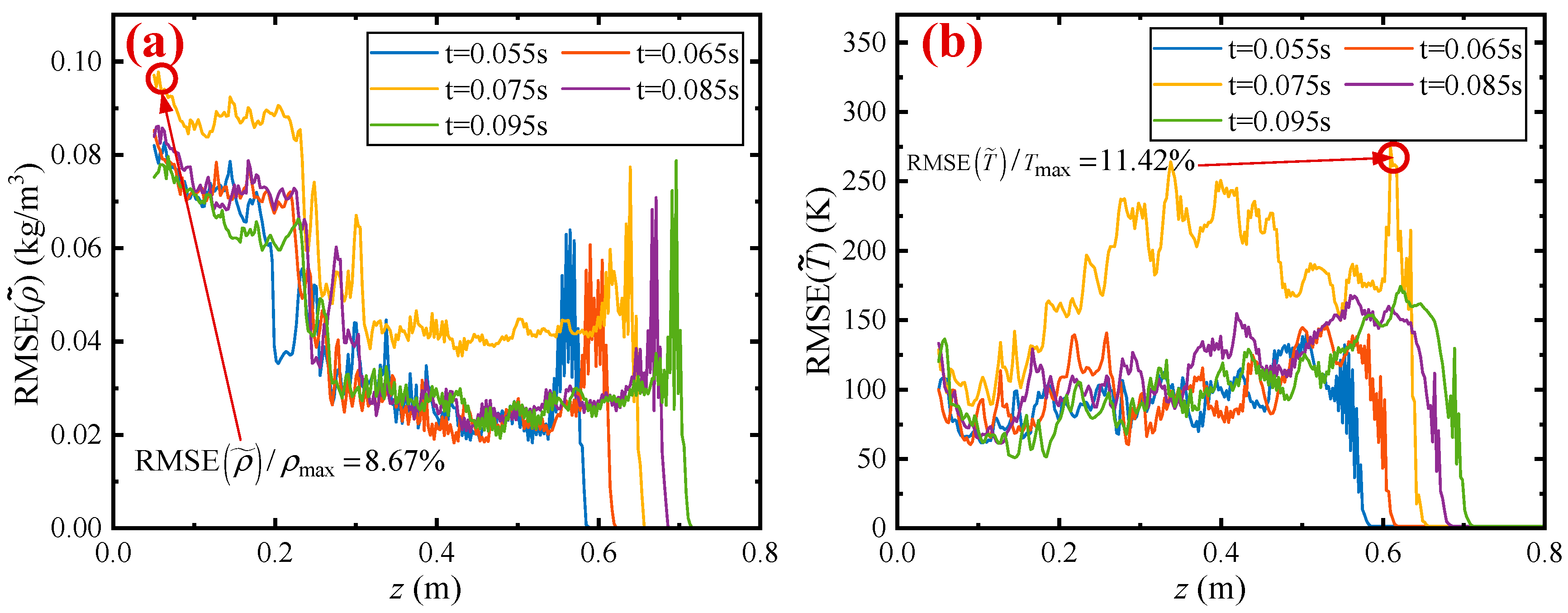

| Species | Molecular Weight [kg/kmol] | |
|---|---|---|
| CO | 28.00 | 2.67 |
| CO2 | 44.01 | 2.26 |
| H2O | 18.02 | 3.12 |
| O2 | 32.00 | 1.89 |
| N2 | 28.01 | 2.38 |
| Air | 28.96 | 2.26 |
| Kd Tree Search Algorithm |
|---|
|
|
|
| Parameter | Value | ||
|---|---|---|---|
| camera frequency | 104 Hz | Aperture F number | 2 |
| Number of cameras | 18 | Circumferential radius | 5 m |
| number of pixels | 640, 480 | focal length | 50 mm |
| pixel size | 4.4 μm, 4.4 μm | Field of view | 14.7°, 11.0° |
Disclaimer/Publisher’s Note: The statements, opinions and data contained in all publications are solely those of the individual author(s) and contributor(s) and not of MDPI and/or the editor(s). MDPI and/or the editor(s) disclaim responsibility for any injury to people or property resulting from any ideas, methods, instructions or products referred to in the content. |
© 2023 by the authors. Licensee MDPI, Basel, Switzerland. This article is an open access article distributed under the terms and conditions of the Creative Commons Attribution (CC BY) license (https://creativecommons.org/licenses/by/4.0/).
Share and Cite
Gao, P.; Zhang, Y.; Yu, X.; Dong, S.; Chen, Q.; Yuan, Y. Reconstruction Method of 3D Turbulent Flames by Background-Oriented Schlieren Tomography and Analysis of Time Asynchrony. Fire 2023, 6, 417. https://doi.org/10.3390/fire6110417
Gao P, Zhang Y, Yu X, Dong S, Chen Q, Yuan Y. Reconstruction Method of 3D Turbulent Flames by Background-Oriented Schlieren Tomography and Analysis of Time Asynchrony. Fire. 2023; 6(11):417. https://doi.org/10.3390/fire6110417
Chicago/Turabian StyleGao, Peng, Yue Zhang, Xiaoxiao Yu, Shikui Dong, Qixiang Chen, and Yuan Yuan. 2023. "Reconstruction Method of 3D Turbulent Flames by Background-Oriented Schlieren Tomography and Analysis of Time Asynchrony" Fire 6, no. 11: 417. https://doi.org/10.3390/fire6110417
APA StyleGao, P., Zhang, Y., Yu, X., Dong, S., Chen, Q., & Yuan, Y. (2023). Reconstruction Method of 3D Turbulent Flames by Background-Oriented Schlieren Tomography and Analysis of Time Asynchrony. Fire, 6(11), 417. https://doi.org/10.3390/fire6110417






